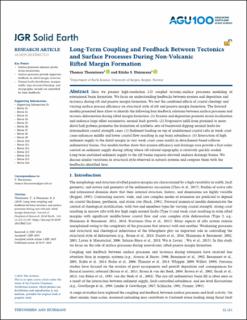Long‐Term Coupling and Feedback Between Tectonics and Surface Processes During Non‐Volcanic Rifted Margin Formation
Journal article, Peer reviewed
Published version

Åpne
Permanent lenke
https://hdl.handle.net/11250/2726822Utgivelsesdato
2019Metadata
Vis full innførselSamlinger
- Department of Earth Science [1050]
- Registrations from Cristin [9791]
Originalversjon
10.1029/2018JB017235Sammendrag
Here we present high‐resolution 2‐D coupled tectonic‐surface processes modeling of extensional basin formation. We focus on understanding feedbacks between erosion and deposition and tectonics during rift and passive margin formation. We test the combined effects of crustal rheology and varying surface process efficiency on structural style of rift and passive margin formation. The forward models presented here allow to identify the following four feedback relations between surface processes and tectonic deformation during rifted margin formation. (1) Erosion and deposition promote strain localization and enhance large offset asymmetric normal fault growth. (2) Progressive infill from proximal to more distal half grabens promotes the formation of synthetic sets of basinward dipping normal faults for intermediate crustal strength cases. (3) Sediment loading on top of undeformed crustal rafts in weak crust cases enhances middle and lower crustal flow resulting in sag basin subsidence. (4) Interaction of high sediment supply to the distal margin in very weak crust cases results in detachment‐based rollover sedimentary basins. Our models further show that erosion efficiency and drainage area provide a first‐order control on sediment supply during rifting where rift‐related topography is relatively quickly eroded. Long‐term sustained sediment supply to the rift basins requires elevated onshore drainage basins. We discuss similar variations in structural style observed in natural systems and compare them with the feedbacks identified here.
